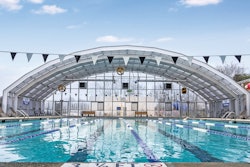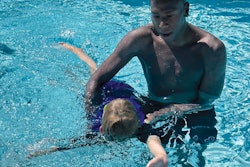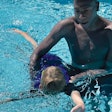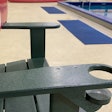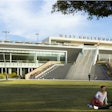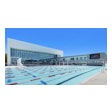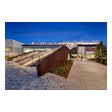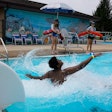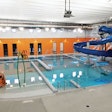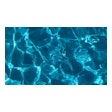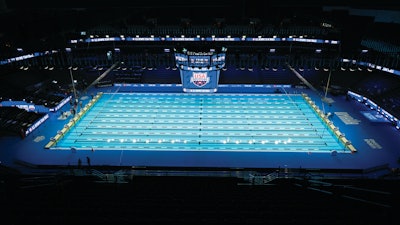
While a competition pool may technically be only as “fast” as the swimmers who compete in it, aquatics professionals continue to work toward an ideal — a perfectly proportioned basin designed to hold clean water at an ideal temperature that produces as little unnecessary resistance as possible.
That may sound like a simple enough goal — a pool is a pool, right? — but it has taken decades to arrive at today’s state-of-the-art natatoriums, and many in the industry are still refining their products and designs with the goal of supporting even faster swimming. Whether you’re planning on hosting a high school swim meet or the Olympic Games, here’s a look at how to design a facility that can provide an optimal environment for any swimmer to realize their personal best.
 Photos courtesy of Counsilman-Hunsaker
Photos courtesy of Counsilman-Hunsaker
Perfect dimensions
Mike Mintenko, director of sales for Myrtha Pools and a two-time Olympic swimmer for Canada, has firsthand knowledge of elite swimming in elite facilities. “At Myrtha, there are certain elements that are integral to how we build the structure,” he says. “The dimensional perfection is one of the things that we really aim to accomplish. And with a modular system, we can really hone in on that dimensional perfection — because you don’t want the pool short, because then it can’t be certified and verified by World Aquatics for a major competition. But obviously, you don’t want it too long, either.”
That a competition pool should be the right length may seem like a no-brainer, but in fact it takes fastidious design to ensure a pool meets regulation measurements. Myrtha’s stainless steel pools are now being used for the upcoming Summer Games in Paris, as well as for the trial pools here in the United States, and one reason for that is their modular nature. Mintenko says the dimensional error threshold for those pools is slim to none. “In terms of the tolerance difference from lane to lane, it’s basically between 3 to 5 millimeters. It’s pretty much dimensionally perfect, so that’s one key thing for a fast competition pool.”
The depth of a pool is also important, as shallow lanes can cause water to deflect off the bottom of the basin and create resistance for swimmers. “I would say minimum 2-meter depth across the board when you’re looking at a major competition pool,” says Mintenko. “But I think a lot of swimmers and coaches ideally like something even deeper — anywhere from 2 to 3 meters in depth. When we do the trials, we’re around 2.7 meters deep.”
Chris Seris, an aquatics consultant for Counsilman-Hunsaker, explains further. “That’s kind of a standard depth — 2 meters. That gives us the depth where it’s safe for doing competition starts where most people, if they’re trained, aren’t going to hit the bottom. And it’s deep enough to allow those waves to go to the bottom and the swimmers pass it before the waves bounce back up and interfere with their stroke.”
Mintenko notes that temporary pools built for events such as the Olympic Trials, which this year are being held at Lucas Oil Stadium in Indianapolis, the depth of the pool can actually affect the set up for the whole event. “It will impact how many seats have to be removed when they build the deck up,” he says. “We put the pool on the stadium floor, and then we build the pool up with our modular structure that then dictates the height or the depth based off of where the seats align.”

Gutter design
When 10 highly trained athletes expend maximum effort for the duration of a race, they naturally create a lot of wave action in the pool. All that energy has to go somewhere, and today’s high-tech gutter systems are designed to dissipate the energy and return water to the pool in a manner that mitigates turbulence.
“When 10 people are diving off starting blocks and swimming as fast as they can, you have water that hits that gutter and the gutter can’t circulate it fast enough,” explains Mark Hines, vice president of sales and marketing at Paddock Pool Equipment, which designs a gutter system for competition pools. “Now you have water sort of backing up into the pool over the top which can create turbulence in the water.”
Hines explains that Paddock’s top-of-the-line system offers a three-channel perimeter gutter with a high-capacity system designed to control dynamic surge through the use of an integrated Auxiliary Surge Recovery chamber. Excess water in the overflow channel is drawn by positive suction into a covered ASR chamber when triggered by an automatic level sensor and returned immediately to the pool. This ensures that the water level is maintained at the rim, minimizing rebound of waves off the pool wall, and preventing the gutter from flooding.
“What we’re trying to do with these systems is to never have either too much water because it’s overflowing the gutter and bouncing back, or have the gutter take so much water that you actually have a water level drop,” explains Hines. “If that were to happen, we can take water that’s in that gutter and push it right back into the pool so that the water level never drops.”

Water temperature
The International Swimming Federation has established that water temperature for standard competitions must be between 77 and 82 degrees Fahrenheit. This temperature range is considered ideal for maintaining the athletes’ health and performance. Water that is warmer than 82 degrees Fahrenheit may help increase a swimmers’ speed, but it also carries higher metabolic and cardiovascular loads and can increase dehydration. Cooler water may also cause health and performance issues.
“My favorite pools and the best competition pools that I’ve been in, I think about the water temperature,” Mintenko says. “Was the water temperature between 79 to 80 degrees? Or was it too warm, where you maybe felt sluggish in the water.”
Water temperature can be maintained with a combination of heating and cooling systems calibrated to achieve the desired temperature range. These systems often employ advanced heat exchangers and energy-efficient pumps to regulate the pool water. Additionally, implementing pool covers during non-competition hours helps to retain heat and reduce energy consumption. Regular monitoring and adjustment of water temperature, coupled with proper insulation of the pool structure, contribute to efficient temperature management and create an ideal environment for competitive swimming events.
Water and air quality
The quality of the air and water in a competition pool can have a dramatic effect on swimmers. Dirty water and air that’s full of chloramines and impurities can impact a swimmer’s breathing and overall health.
Scott Hyland, a sales representative for Neptune Benson, which makes water filtration systems for competition pools, notes that large bodies of water, such as an Olympic swimming pool, need to be filtered on a massive scale to ensure the water is clean. “Right now, we’re preparing for the Olympic trials at Lucas Oil Stadium, and those are 50-meter competition pools,” says Hyland. “Our systems can turn all that water over every three hours.”
But during a competition that rate of filtration is decreased to ensure minimum resistance for the swimmer. “For a competition, we’re going to decrease that to a standard five- or six-hour turnover,” Hyland explains. “Because now we’re turning over 2,500 gallons of water a minute, and you’ve got that coming back to the pool.”
Where that water re-enters the pool is also important, says Hyland. “If you have those return outlets up high and facing the swimmers, that’d be like them swimming against a current, so you want to be sure that the return outlets are low in the water.”
Ensuring that the water is clean is the prime objective, however, as dirty water can lead to smelly, and sometimes noxious air. Hyland notes the reality of what actually goes on in a pool. “I think educating the industry on what takes place in a pool is important,” he says. “Chlorine interacts with sweat, urine, bodily fluids. I mean you’re sweating when you’re swimming. You just don’t notice it, because you’re in a pool. To be honest, people are going to the bathroom in the pool, especially when they’re in a meet and they’re wearing a tight suit and don’t have time to get to a restroom. When those bodily fluids interact with chlorine, it creates chloramines. When you go to a hotel, you can smell your way to the pool. And everybody’s like, ‘Oh, that’s the chlorine.’ No, it’s not the chlorine. It’s the off-gassing of the chlorine interacting with organics.”
Seris says air and water quality have to be considered in the early stages of designing a natatorium. “In an indoor facility, we have to have good air quality,” he says. “Water chemistry, air movement, and replacement of air in a natatorium are all very important. Poor air quality can affect the health of the swimmers, the officials and the coaches — everybody who’s in that facility. So, we have to take that into consideration, and we’ll coordinate a lot with operators and suppliers of those components when we’re designing facilities.”
Light
Natatorium lighting may not directly help a swimmer break a record, but it can impact how everyone in a natatorium experiences an event.
When designing lighting for a competition pool, several factors need to be considered to ensure optimal performance and safety. Choosing light fixtures with high IP can withstand the high humidity and chemical exposure typically found in indoor pool environments is essential. Additionally, fixtures with high CRI (Color Rendering Index) should be selected to accurately render colors, enhancing visibility and ensuring competitors can discern objects with precision.
Proper placement and distribution of lighting fixtures is also important. Directing light toward the water surface at angles that minimize glare ensures clear visibility for swimmers, judges and spectators. Underwater lighting should also be considered, as it plays a role in illuminating the pool bottom evenly, aiding swimmers in gauging distances and maintaining their trajectory during races. Peripheral lighting around the pool deck and spectator areas enhances overall visibility and ambiance, contributing to a comfortable and immersive competition experience.
As for natural light, Seris says that windows and skylights always improve the overall ambiance of a natatorium, but notes a few challenges. “We always take lighting into consideration,” says Seris. “It just feels better in a facility to have some natural light. But glare can be an issue, so if you have spectator seating, you want them to have the sun at their backs so the glare isn’t affecting them and they can see what’s happening in the pool.”

Starting blocks and lane lines
Starting block and lane line technology has come a long way. Starting blocks, traditionally a simple platform for swimmers to launch from, have undergone significant innovation. One notable development is the incorporation of adjustable footrests and back plates, allowing swimmers to customize their starting position for optimal power.
These adjustable features accommodate a wide range of body sizes and preferences, providing athletes with greater control and comfort at the start of races. Some modern starting blocks feature sensors and pressure-sensitive pads that provide real-time feedback on a swimmer’s reaction time and force exertion. This data not only helps athletes fine-tune their starts but also enables coaches to analyze and optimize performance.
Lane line designs have also changed significantly to minimize disruptions during races. Traditional lane lines consisting of floating discs connected by cables have evolved into sophisticated systems that incorporate hydrodynamic features. Today’s lane lines are designed to reduce turbulence and wave propagation, creating smoother swimming conditions and minimizing energy expenditure for athletes. The addition of color variations and LED lighting systems have also enhanced visibility for swimmers, officials and spectators, particularly in indoor swimming facilities where lighting conditions may vary.
These are just a few of the elements that contribute to the creation of an ideal environment for any competitive swimmer. Beyond the technical specs and fancy equipment, there are the intangibles — the design, the atmosphere, the overall feel of the place.
When asked whether there’s one competition pool that stands out as an elite facility, Seris admits that he’s partial to the Mizzou Aquatic Center but, he says with a chuckle, not because Counsilman-Hunsaker designed it or because he was the aquatics director there.
Aside from the fond memories and his connections to Mizzou and all of the technical aspects of the facility being done right, the overall feel of the facility differentiates it from other competitive venues. “It is not a cool-feeling facility,” he says. “Natatoriums are often painted white, and they just feel sterile and cold. Just the treatments of the natatorium can really make it feel better. We used warmer colors in there, which made it more hospitable. There’s a lot of natural light in that facility — lots of windows, skylights, and it just had a good feel to it. I’ve worked in facilities and run facilities that didn’t have that kind of feel.”
Another person who undoubtedly has fond memories of the Mizzou Aquatics Center is Michael Phelps, the fastest swimmer in the world at one time. “We were able to host a USA Grand Prix meet there for several years,” Seris says. “Several world records were broken in there. I got to verify a world record by Michael Phelps in that pool. That’s a highlight of my career.”
For Mintenko, the intangible that really can’t be designed for is the competitive atmosphere that can be found in almost any natatorium during a big race. “For me it was really the environment itself. Maybe it’s a college meet, or maybe it’s the Olympic Games, and everyone’s kind of in there, and you can feel that energy brewing. That’s something that I think as an athlete that I’ve certainly experienced in the past, and that, to me, is what makes a great competition pool.”
















